Pere Lachaise Cemetery – A Walking Tour with David Burke
A few days ago I filed a post on a self-guided walk in Montmartre Cemetery and that visit spurred me to want to visit Pere Lachaise Cemetery, its much better known big sister. While Montmartre is reasonably compact with only one way in and out, Pere Lachaise is massive with considerable elevation change and multiple entry points. Looking at the map convinced me that I needed a guided tour.
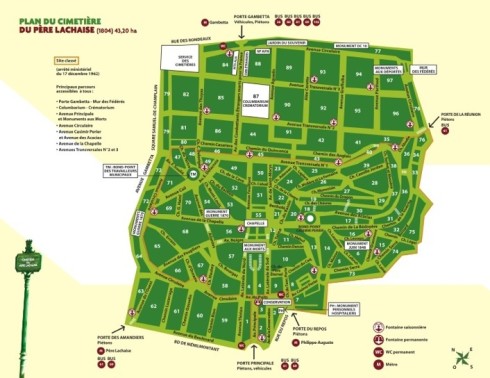
A couple of days before we had taken a guided walking tour of areas frequented by the young Ernest Hemingway. The tour was led by David Burke, author of Writers in Paris and leader of Writers in Paris Walking Tours. I wrote about it here.
Our group included myself and wife Alison plus my sisters Anne and Kaye. David charges 50 euros per person and believe me, on the ground Pere Lachaise is so confusing that having David escort you through is worth every euro. David suggested meeting outside the Gambetta metro station so we could walk downhill to the main entrance and take the metro back from the Pere Lachaise station.
Pere Lachaise Cemetery
We met David as planned and entered the northern end of the cemetery. As we headed to the first site he gave us a run down on its history and the fact that when it was opened it was so far from the centre of Paris that it attracted few interments. Then someone hit upon the brilliant idea of moving some celebrity remains here, starting by uniting the legendary lovers Peter Abelard and Heloise who died way back in the 12th century. This internment was followed by the playwright Moliere and his boon companion Jean de la Fontaine who both died in the 1600s. The ploy was so success that Pere Lachaise is the repository of perhaps more famous remains than any other cemetery in the world. Getting a plot here today is out of the question for all but the wealthiest who wish to bask in the glow of the more famous residents.
We started our visit off essentially where our Hemingway tour ended a few days before, with Gertrude Stein. For thirty-five years she held court in her studio at 27 Rue de Fleuros entertaining and encouraging young writers and artists. Now here she is in a modest grave in Pere Lachaise with three admirers.
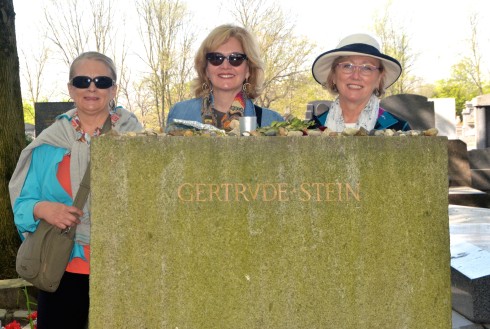
What is really interesting about this grave is that on the other side of it is Gertrude’s longtime lover, Alice B. Toklas, as David points out.
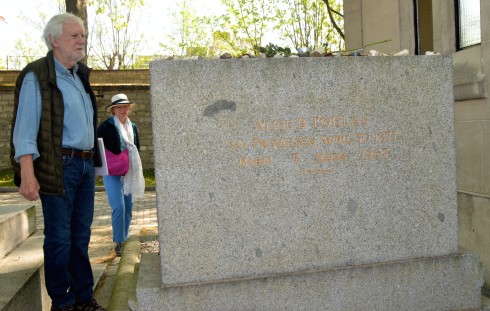
Paris in the early 20th century would have been one of the few cities where a couple could live in an openly gay relationship without raising a fervor.
As we headed for the next literary grave I couldn’t help but notice this the tomb of Joseph Speiss because of the bronze airship on it. Turns out he designed an airship a year before the much more famous Ferdinand von Zeppelin, but it literally didn’t get off the ground until years after the German had his air machines perfected.
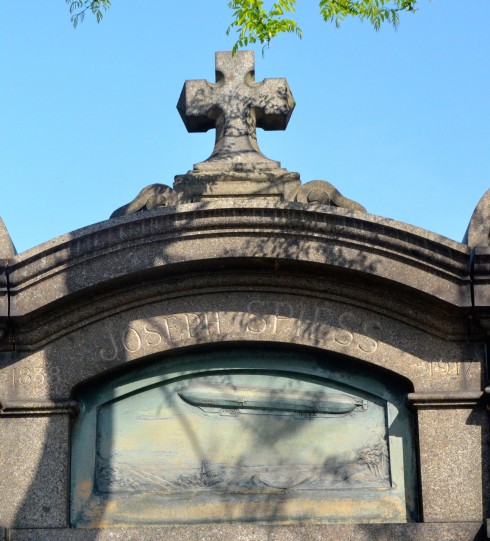
Next up was one of the literary giants who also was known for his flamboyant lifestyle as much as for his writing – Oscar Wilde. Unlike Gertrude Stein, Wilde was persecuted and prosecuted for his homosexuality to the point of being imprisoned in Reading gaol from whence he wrote The Ballad of Reading Gaol. Although he died in poverty in Paris in 1900 he did not die in obscurity and after a period of rest in an ordinary grave, wealthy benefactors commissioned famed sculptor Jacob Epstein to create this memorable tomb which has become a pilgrimage site for many as you can see from the kisses on the side of the grave.
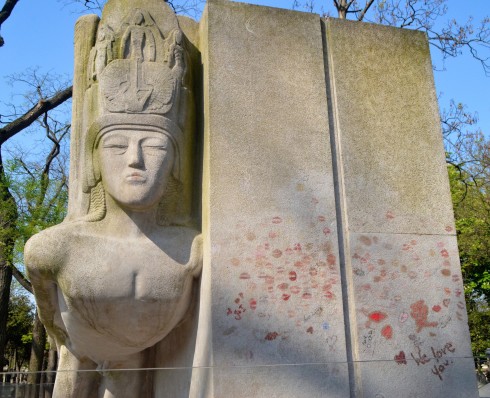
Here is the front view.
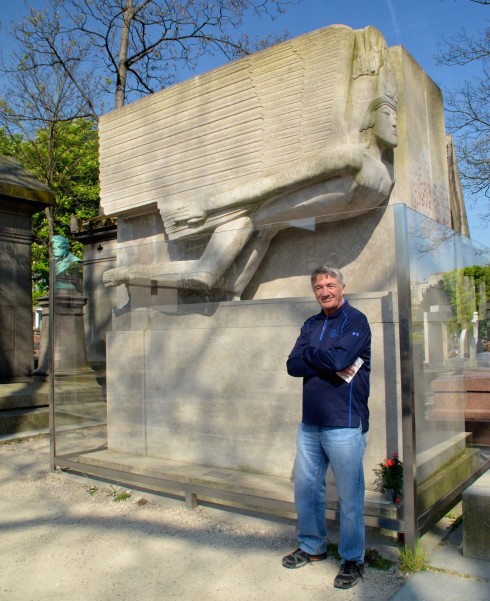
Unfortunately the lower half of the tomb has had to be protected by a plexiglass shield to prevent over eager worshipers from chipping off parts of the genitals of the sphinx-like figure.
After Oscar, we veered away from the literary theme to visit the grave of someone who was a nobody in life but became a celebrity in death, Victor Noir. Noir was an unremarkable journalist who was sent on an errand to deliver a letter to Prince Pierre Bonaparte, a cousin of Napoleon III. As Noir attempted to pull the letter out of his coat pocket, Napoleon believed he was drawing a gun to assassinate him and fired first, killing young Noir. This murder caused an outrage in Paris and over 100,000 people showed up for his funeral. The supine bronze likeness of Noir is outstanding and has developed a cult-like following.
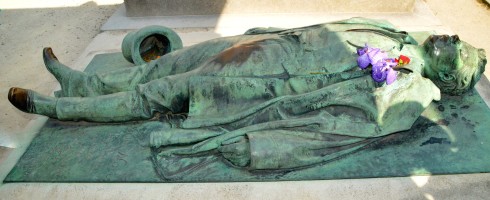
Notice the shiny protuberance on his mid-section. Women looking to get pregnant visit the statue and rub Noir’s genital area, although apparently the ends of the feet and the mouth will also do. Pretty bizarre, but of all the tombs we visited today, Noir’s had the most people around it.
Next up are another set of legendary lovers, much more modern than Abelard and Heloise. Famed French film personalities Simone Signoret and Yves Montand are buried together. Here they are in life.
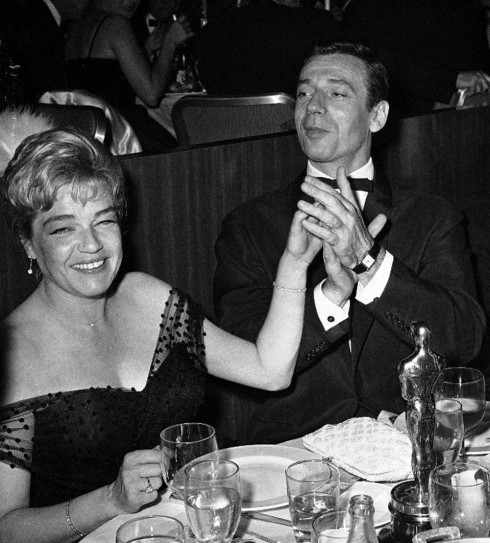
And death.
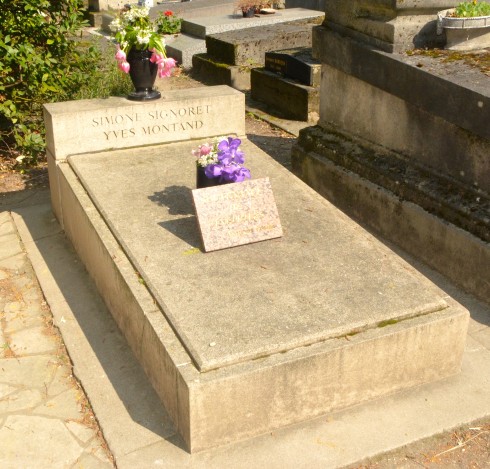
Anyone who has ever attempted to read Remembrance of Things Past in English might not be too upset that the author is dead and buried in Pere Lachaise, but there is no denying that Marcel Proust was a literary genius of the highest order. David pointed out that the current grave marker is a recent replacement of the original marker with Marcel the centrepiece rather than his father.
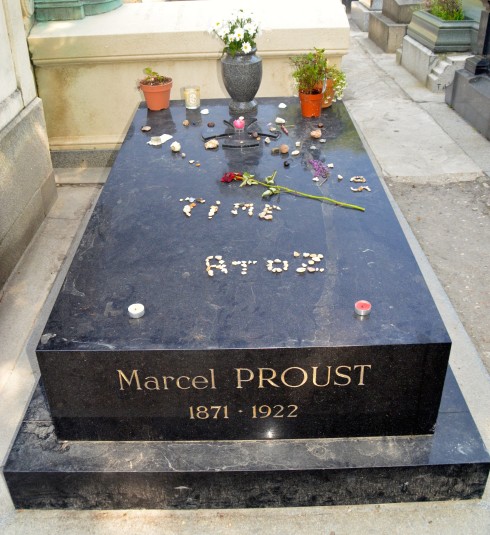
David was quite animated in taking us to the next grave, that of Polish cum French poet, playwright and art critic Guilliame Apollinaire.
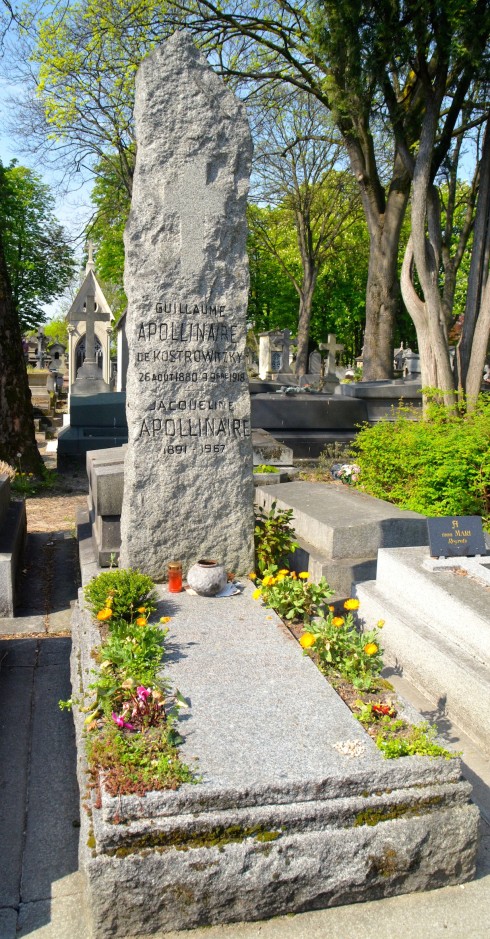
Every year on the anniversary of his death David and a number of other Apollinaire fans meet here and then follow it up with a bibulous meeting at a brasserie nearby. Those are the type of traditions I can relate to.
Veering off the literary path once again we came to another of the graves that has become a homage site, this time by spiritualists and others who believe in communication with the dead. Allan Kardec was the founder of Spiritism which sensible people would call balderdash, but then again the world is deficient in sensible people so thousands flock here annually in an attempt to commune with his spirit. If flowers are the medium that allows this to happen then Kardec might be easier to get hold of than I thought.

Eugene Delacroix may be the consummate French painter – not quite an impressionist, not quite a Barbizon, not quite a Mannerist – just a genuine original. Is there a more iconic French painting than Liberty Leading the People?
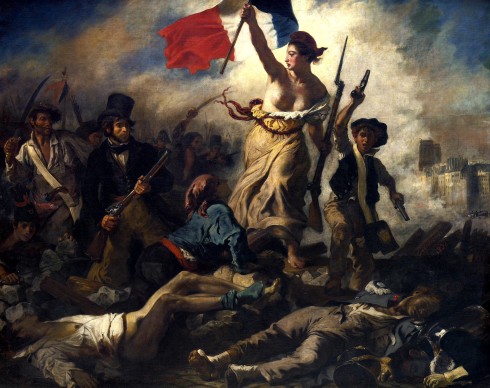
Here is Alison, a good painter in her own right, with the great Delacroix.
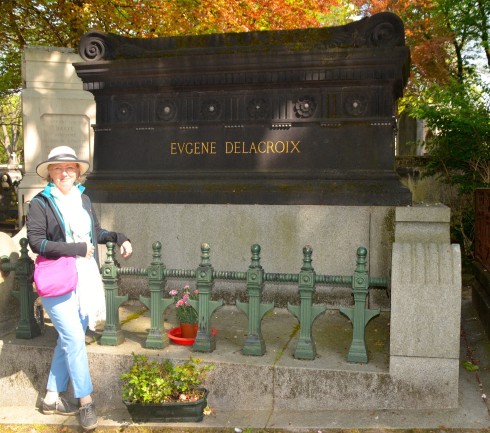
Returning to the writer’s theme we come across another biggie, Honore de Balzac author of the massive La Comedie Humaine which is considered one of the most influential series of writings ever produced. The list of writers influenced by Balzac is a who’s who of 19th and 20th century greats. His tomb is elegantly simple, if that’s not an oxymoron.
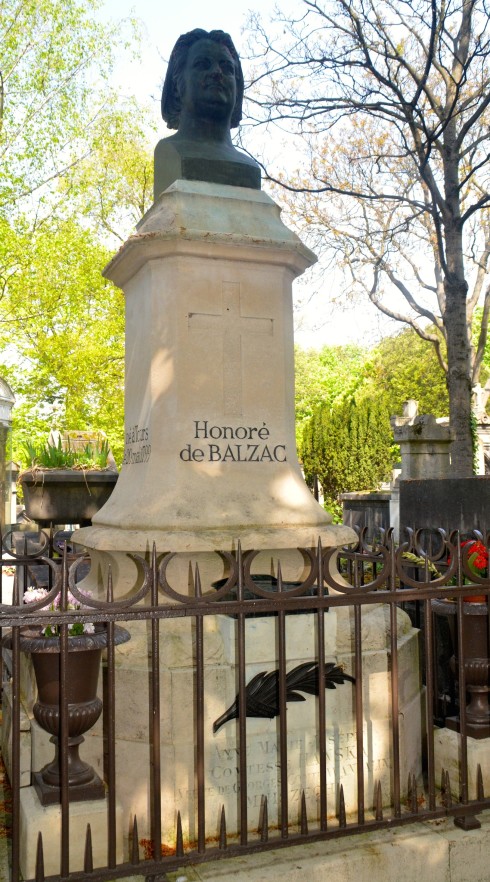
Pere Lachaise is home not only to thousands of persons interred in marked graves. It also has a huge columbarium where the cremated remains of thousands of others occupy much smaller spaces.
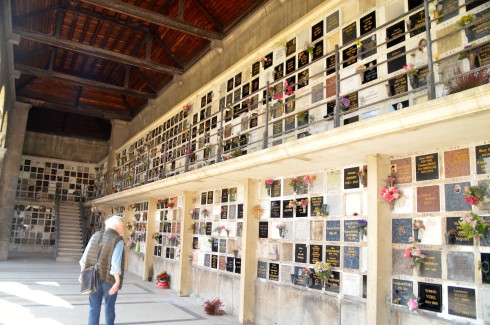
One famous American writer found in the columbarium is Richard Wright, the author of the then controversial autobiography Black Boy which chronicles the life of a dirt poor black man’s struggle to get out of Mississippi in the Jim Crow era and further himself through education.
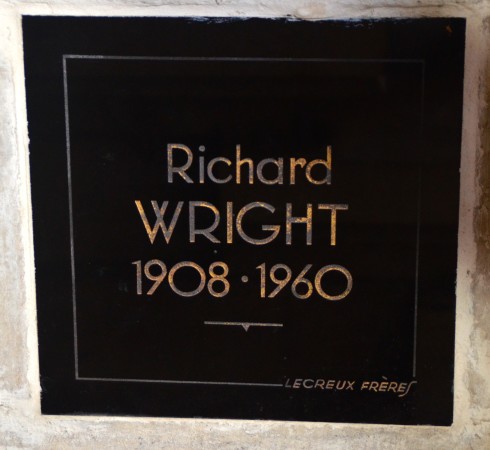
By now we were deep into the interior of Pere Lachaise and I could appreciate the beautiful mature specimen trees that were just coming into bloom and the canopied avenues that make this place such a popular place for Parisiennes to wander. Here’s David with Alison, Anne and Kaye.
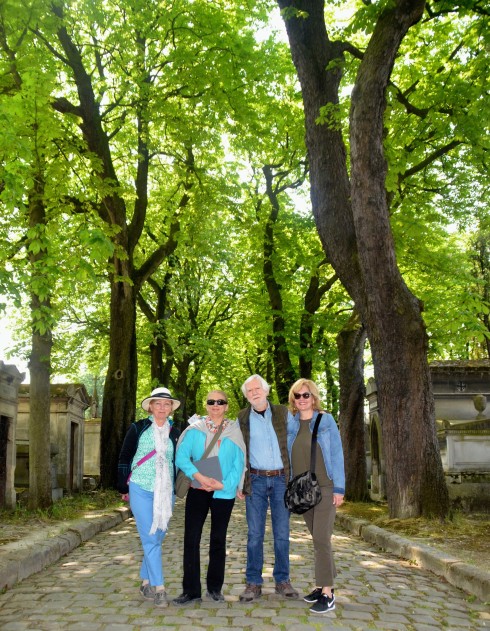
Finally we arrive at the tombs of two of the original celebrity reburials. Here are Moliere and La Fontaine side by side on the edge of a hill in a very sylvan part of Pere Lachaise.
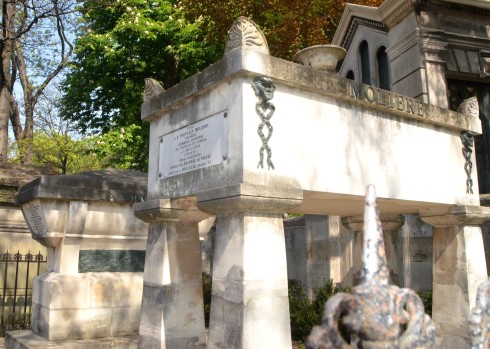
While there are plenty of literary superstars in Pere Lachaise there is one celebrity here who was a modern superstar as that term is usually applied to rock stars. I’m referring of course to Jim Morrison who has probably done more to popularize Pere Lachaise than any other figure. His grave has become a shrine and his pilgrims somewhat of a nuisance as they vandalize the nearby graves with graffiti that needs to be cleaned regularly. With the famous bust that used to be here long stolen, frankly the grave site is anticlimactic, but I don’t think the Lizard King would give a shit.
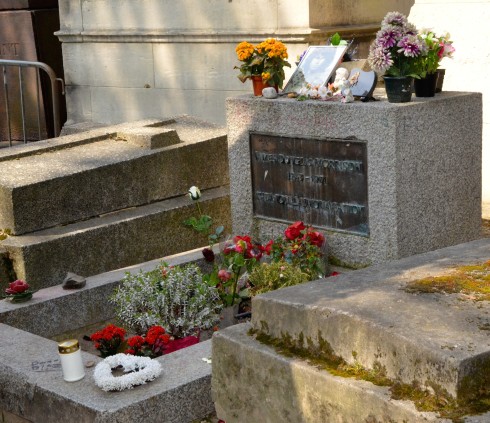
By now we are nearing the lower entrance and this is where you will find the gothic like sepulchre of Abelard and Heloise, while separated in life, they are now united in death.
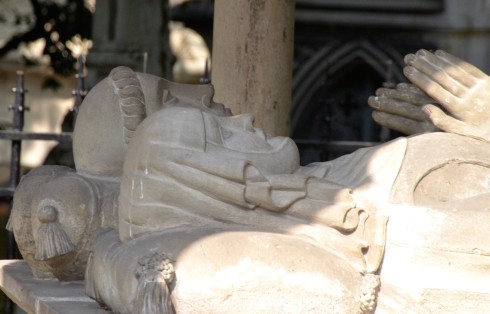
Colette is the surname of famous French writer Sidonie-Gabriele Colette who is a national treasure in France known for her tempestuous lifestyle which is mirrored in her most famous novel Gigi. Her simple tomb belies her flamboyant career.
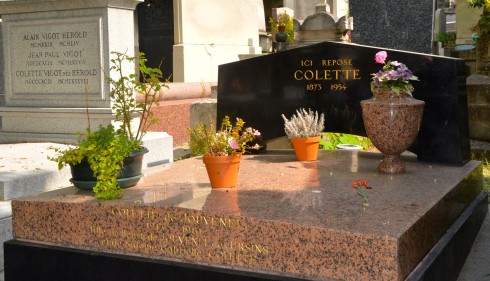
One person I really didn’t expect to find in Pere Lachaise was perhaps the greatest opera composer of all time, Gioachino Rossini or just Rossini as most of us know him. David explained that Rossini was a francophile who spent the last fifteen years of his life in Paris. It was here that he composed what to me as a boy watching the opening credits of The Lone Ranger was the most thrilling music I had ever heard, the William Tell Overture. His tomb is nice, but not overly ornate and here’s a little not so unknown secret – he’s not in it. In 1887 the Italian government wanted him back and his remains are now in Florence where I was sure I had seen them years ago, but don’t tell that to the people leaving flowers.
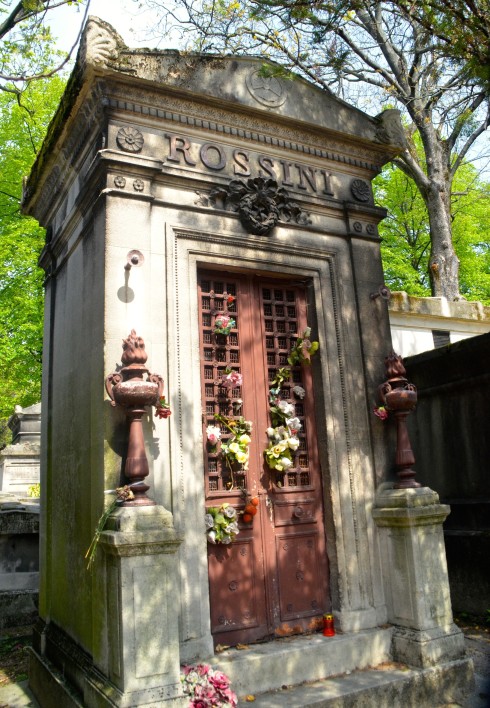
We are getting near the end of this walk, but not before seeing the tomb of probably the most influential person in this cemetery in shaping the destiny of this city. Baron Georges-Eugene Haussmann was tasked by Napoleon III to turn the medieval labyrinth of streets that existed up until the middle of the 19th century into a modern city and Haussmann accepted the challenge with a passion. You have him to thank for Paris’ wide boulevards and Belle Epoque buildings that are now considered quintessentially Parisienne. While extremely controversial at the time, Haussmann’s urban renewal, like Eiffel’s tower, have gone from being reviled to revered.
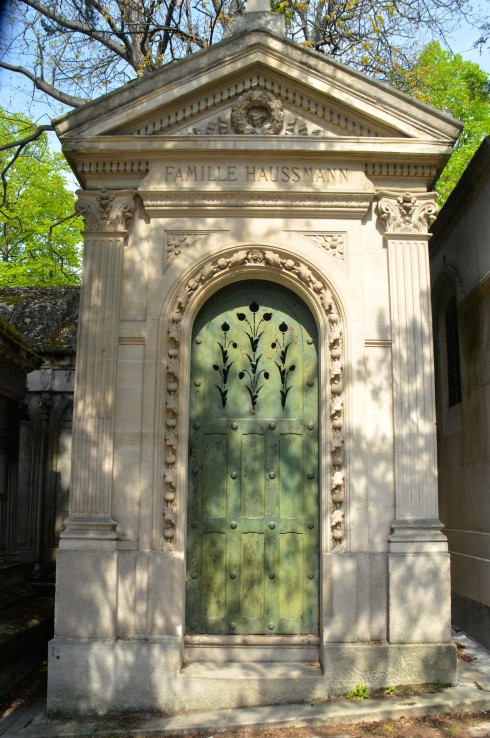
Our last stop was to another prone statute, this time Felix Faure, a former President of France who died while allegedly getting a blow job from a much younger woman. I wonder if this is what he looked like as he hit the floor.
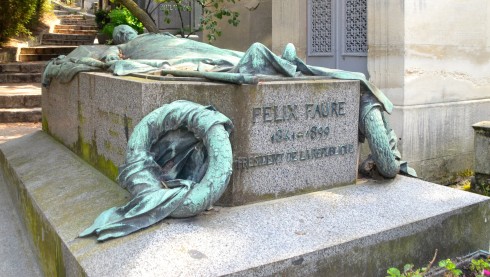
Okay, so that’s our tour of Pere Lachaise with the inestimable guide David Burke. We retired to the watering hole where he and fellow Apollinaire devotees gather each year and had a farewell libation. We hope to get back next year and take another one of David’s walking tours. Adieu from Pere Lachaise. If you are interested in Parisian cemeteries other than Montmartre and Per Lachaise please read my post on Montparnasse Cemetery, another great one in the City of Light.

